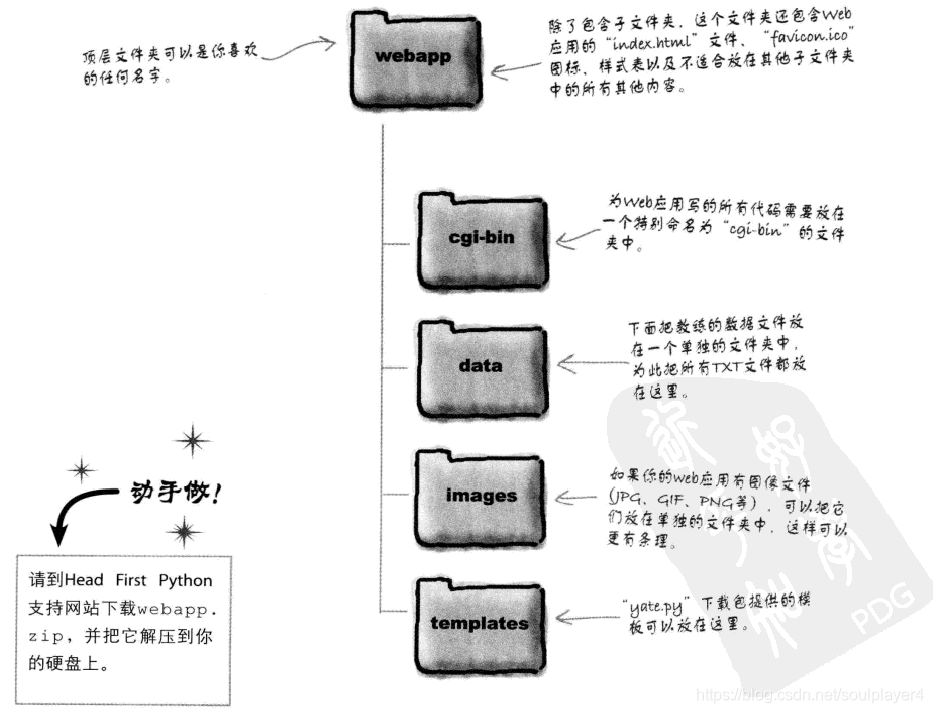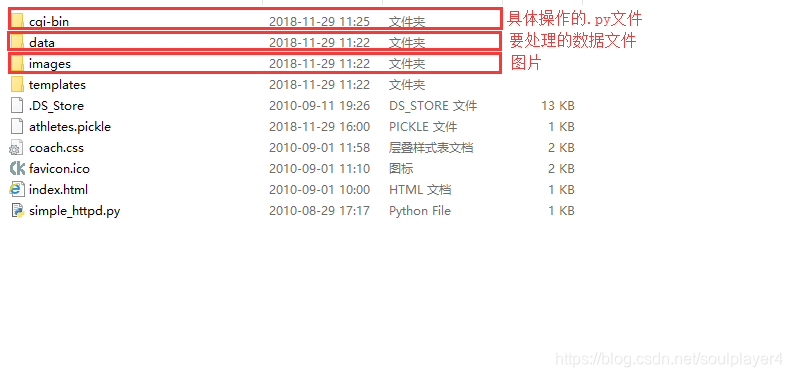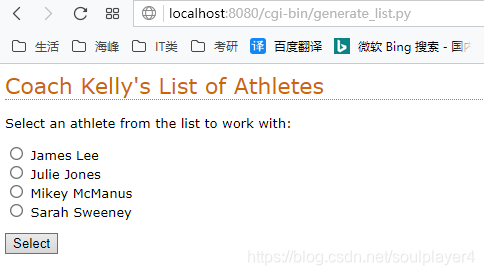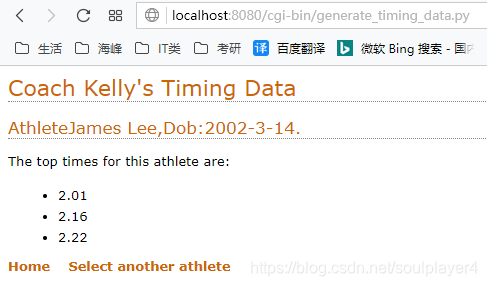要点
- pop(0) :调用将删除并返回列表最前面的数据项。
- “映射”,“散列”,“关联数组”,实际上就是指“字典”
- 创建字典两种方法
- cheese = {}
- paline = dict()
- set的作用:set会自动去掉重复的元素.dict的作用是建立一组 key 和一组 value 的映射关系,dict的key是不能重复的。有的时候,我们只想要 dict 的 key,不关心 key 对应的 value,目的就是保证这个集合的元素不会重复,这时,set就派上用场了。set 持有一系列元素,这一点和 list 很像,但是set的元素没有重复,而且是无序的,这点和 dict 的 key很像。创建 set 的方式是调用 set() 并传入一个 list,list的元素将作为set的元素。
铺垫
"""
现有几个数字,记录运动员的速度。你需要做的有
1.处理数据为规范数字
2.去重,排序
3.寻找某人前3的成绩是什么
4.有新加入的时间
"""
#创建一个函数,用来使数字规范化
def sanitize(time_string):
if '-' in time_string:
splitter = '-'
elif ':' in time_string:
splitter = ':'
else:
return(time_string)
(mins,secs)=time_string.split(splitter)
return(mins+'.'+secs)
#创建一个类,类的作用就是用来处理传入的文件,去重,排序,找到前三的成绩
class Athelete():
#先创建一个初始化函数
def __init__(self,a_name,a_bir=None,a_times=[]):
self.name = a_name
self.bir = a_bir
self.times = a_times
#找到top3的成绩,先一个一个取,先规范化,再去重,再排序
def top3(self):
return(sorted(set({sanitize(i) for i in self.times}))[0:3])
#新加入的时间,将此时间加入到时间列表里
def add_time(self,time_value):
self.times.append(time_value)
def add_times(self,time_list):
self.times.extend(time_list)
#创建一个函数,用来处理传入的文件,文件要以“,”逗号进行分隔,要去空。
def get_coach_date(file_name):
try:
with open (file_name) as f:
data = f.readline()
tmp = data.strip().split(',')
return(Athelete(tmp.pop(0),tmp.pop(0),tmp))
except IOError as ioerr:
print('File error:'+str(ioerr))
return(None)
#调用验证
james = get_coach_date('james2.txt')
print(james.name,"'s faster times are:"+ str(james.top3()))
viva = Athelete('VIVA')
viva.add_times(['2.22','2-23','2:24'])
print(viva.top3())
# atheletelist是刚刚编写号的模块,是一个.py的文件,放在同一个文件夹下
import pickle
from atheletelist import Atheletelist
def get_coach_date(filename):
try:
with open(filename) as f:
data = f.readline()
tmp = data.strip().split('.')
return(Atheletelist(tmp.pop(0),tmp.pop(0),tmp))
except IOError as irror:
print("Filr Error"+str(irror))
return(None)
def put_to_store(file_list):
all_athletes={}
for eache_file in file_list:
ath = get_coach_date(eache_file) #将各个文件转换为一个AthleteList对象实例,并把选手的数据增加到字典
all_athletes[ath.name] = ath #每个选手的名字作为字典的键,值是AthleteList对象实例
try:
with open('athletes.pickle','wb') as athf:
pickle.dump(all_athletes,athf) #将整个AthleteList增加到一个pickle中
except IOError as ioerr:
print('File error(put_to_store):' +str(ioerr))
return(all_athletes)
def get_from_store():
all_athletes = {}
try:
with open('athletes.pickle','rb') as athf:
all_athletes = pickle.load(athf) #将pickle读入字典
except IOError as ioerr:
print('File error(get_from_store):' +str(ioerr))
return(all_athletes)
generate_list.py
import athletemodel
import yate
import glob
data_files = glob.glob('data/*.txt')
athletes = athletemodel.put_to_store(data_files)
print(yate.start_response())
print(yate.include_header("Coach Kelly's List of Athletes"))
print(yate.start_form("generate_timing_data.py"))
print(yate.para("Select an athlete from the list to work with:"))
for each_athlete in athletes:
print(yate.radio_button("which athlete",athletes[each_athlete].name))
print(yate.end_form("Select"))
print(yate.include_fotter({"Home":"/index.html"}))
以上是做实验时写的东西
正式web数据在书中有说,可以去深入浅出的官网进行下载
链接: http://python.itcarlow.ie/resources.html
解压后的文件夹


文件夹下的具体文件内容

开发内容
cgi-bin文件夹中
athletelist.py
#定义一个类
class AthleteList(list):
#先创建一个初始化函数
def __init__(self, a_name, a_dob=None, a_times=[]):
list.__init__([])
self.name = a_name
self.dob = a_dob
self.extend(a_times)
#规范化传入的时间内容
@staticmethod
def sanitize(time_string):
if '-' in time_string:
splitter = '-'
elif ':' in time_string:
splitter = ':'
else:
return(time_string)
(mins, secs) = time_string.split(splitter)
return(mins + '.' + secs)
#@property 是一个修饰符,可以使类表现的像是一个类属性
#找出前三的时间
@property
def top3(self):
return(sorted(set([self.sanitize(t) for t in self]))[0:3])
#清空内容
@property
def clean_data(self):
return(sorted(set([self.sanitize(t) for t in self])))
athletemodel.py
import pickle
from athletelist import AthleteList
def get_coach_data(filename):
try:
with open(filename) as f:
data = f.readline()
templ = data.strip().split(',')
return(AthleteList(templ.pop(0), templ.pop(0), templ))
except IOError as ioerr:
print('File error (get_coach_data): ' + str(ioerr))
return(None)
def put_to_store(files_list):
all_athletes = {}
for each_file in files_list:
ath = get_coach_data(each_file)
all_athletes[ath.name] = ath
try:
with open('athletes.pickle', 'wb') as athf:
pickle.dump(all_athletes, athf)
except IOError as ioerr:
print('File error (put_and_store): ' + str(ioerr))
return(all_athletes)
def get_from_store():
all_athletes = {}
try:
with open('athletes.pickle', 'rb') as athf:
all_athletes = pickle.load(athf)
except IOError as ioerr:
print('File error (get_from_store): ' + str(ioerr))
return(all_athletes)
generate_list.py
#导入之前创建的模块
import athletemodel
import yate
#利用glob模块可以在操作系统中查询文件名
import glob
data_files = glob.glob('data/*.txt')
athletes = athletemodel.put_to_store(data_files)
print(yate.start_response())
#开始生成web页面,提供一个合适的标题
print(yate.include_header("Coach Kelly's List of Athletes"))
#开始生成表单,提供要链接的服务器端程序名
print(yate.start_form("generate_timing_data.py"))
print(yate.para("Select an athlete from the list to work with:"))
#为各个选手分别生成一个单选钮
for each_athlete in athletes:
print(yate.radio_button("which_athlete",athletes[each_athlete].name))
#创建一个提交按钮
print(yate.end_form("Select"))
print(yate.include_fotter({"Home":"/index.html"}))
generate_timing_data.py
#导入要用的库和模块
#导入Python的CGI模块来访问表单数据,这也是标准库中的一个模块
import cgi
#Python的标准库提供了一个CGI跟踪模块(名为DGITB),启用这个模块时,会在web浏览器上显示详细的错误信息。这些信息可以帮你找出CGI哪里出了问题。改正错误并且CGI正常工作后,再关闭CGI跟踪
import cgitb
cgitb.enable()
import athletemodel
import yate
#从模型得到数据
#调用athletemodel中的方法,获取pickle中的数据
athletes = athletemodel.get_from_store()
#访问你所选择的表单,德大表单数据
#再得到表单数据中单选按钮选择的数据"which_athlete"
form_data=cgi.FieldStorage()
athlete_name = form_data['which_athlete'].value
#生成所需要的HTML页面
#获取选手的名字和出生日期
print(yate.start_response())
print(yate.include_header("Coach Kelly's Timing Data"))
print(yate.header("Athlete"+athlete_name +",Dob:"+athletes[athlete_name].dob+"."))
#将前三个时间转换为一个无序HTML列表
print(yate.para("The top times for this athlete are:"))
#这个web页面的最下面有两个链接
#这里把top3看成一个类的属性,所以不写成top3()的形式
print(yate.u_list(athletes[athlete_name].top3))
print(yate.include_footer({"Home":"/index.html","Select another athlete":"generate_list.py"}))
yate.py这是一个前端展现,在MVC中是View
#从string模块中导入Template类,这个类的可以进行简单的字符串替换
from string import Template
def start_response(resp="text/html"):
return('Content-type: ' + resp + '\n\n')
def include_header(the_title):
with open('templates/header.html') as headf:
head_text = headf.read()
header = Template(head_text)
return(header.substitute(title=the_title))
def include_footer(the_links):
with open('templates/footer.html') as footf:
foot_text = footf.read()
link_string = ''
for key in the_links:
link_string += '<a href="' + the_links[key] + '">' + key + '</a> '
footer = Template(foot_text)
return(footer.substitute(links=link_string))
def start_form(the_url, form_type="POST"):
return('<form action="' + the_url + '" method="' + form_type + '">')
def end_form(submit_msg="Submit"):
return('<p></p><input type=submit value="' + submit_msg + '"></form>')
def radio_button(rb_name, rb_value):
return('<input type="radio" name="' + rb_name +
'" value="' + rb_value + '"> ' + rb_value + '<br />')
def u_list(items):
u_string = '<ul>'
for item in items:
u_string += '<li>' + item + '</li>'
u_string += '</ul>'
return(u_string)
def header(header_text, header_level=2):
return('<h' + str(header_level) + '>' + header_text +
'</h' + str(header_level) + '>')
def para(para_text):
return('<p>' + para_text + '</p>')
最后生成界面
用Python构建一个Web服务器必须有以下这5行代码
通用网关接口(Comman Gateway Interface,CGI)是一个Internet标准,允许Web服务器运行一个服务器端程序,成为CGI脚本。
一般地,CGI脚本都放在一个名为cgi-bin的特殊文件夹下,这样Web服务器才能知道在哪里查找CGI脚本。
在我们的下载文件里有一个simplehttpd.py的文件,它提供了一个支持CGI的Web服务器。
Python提供了它自己的Web服务器,这个Web服务器包含在http.server库模块中。
#导入HTTP服务器和CGI模块
from http.server import HTTPServer, CGIHTTPRequestHandler
#指定一个端口
port = 8080
#创建一个HTTP服务器
httpd = HTTPServer(('', port), CGIHTTPRequestHandler)
#显示一个友好的信息,并启动服务器
print("Starting simple_httpd on port: " + str(httpd.server_port))
httpd.serve_forever()
---------------------
作者:星际丶牛仔
来源:优快云
原文:https://blog.csdn.net/ahaha413525642/article/details/76407412
版权声明:本文为博主原创文章,转载请附上博文链接!
-
主页

-
点击timing data 转到 generate_list.py 生成的界面中

-
选择任意选手,进入到 generate_timing_data.py 生成的页面中

Tips:
- @property 是一个修饰符,可以使类表现的像是一个类属性
- cgi.FieldStorage()访问作为Web请求一部分发送给Web服务器的数据,数据作为一个Python字典。







 本文介绍使用Python进行Web开发的过程,包括处理数据规范化、去重、排序等操作,通过类实现数据管理和展示,以及如何构建Web服务器和生成动态网页。
本文介绍使用Python进行Web开发的过程,包括处理数据规范化、去重、排序等操作,通过类实现数据管理和展示,以及如何构建Web服务器和生成动态网页。
















 1345
1345

 被折叠的 条评论
为什么被折叠?
被折叠的 条评论
为什么被折叠?








